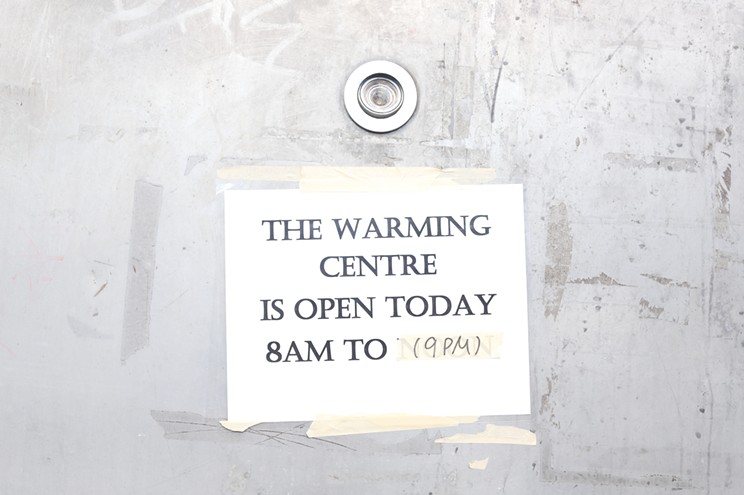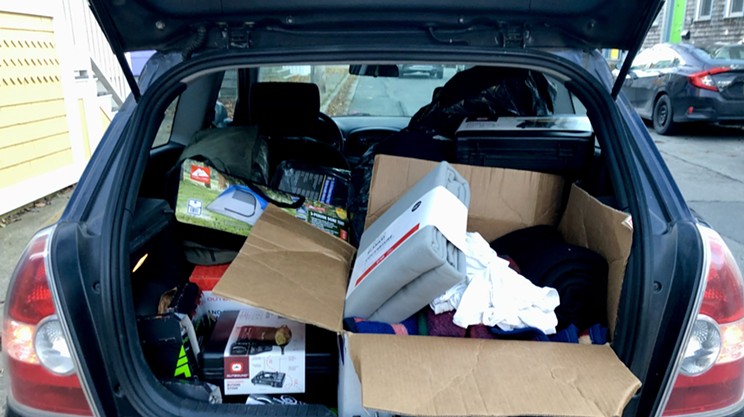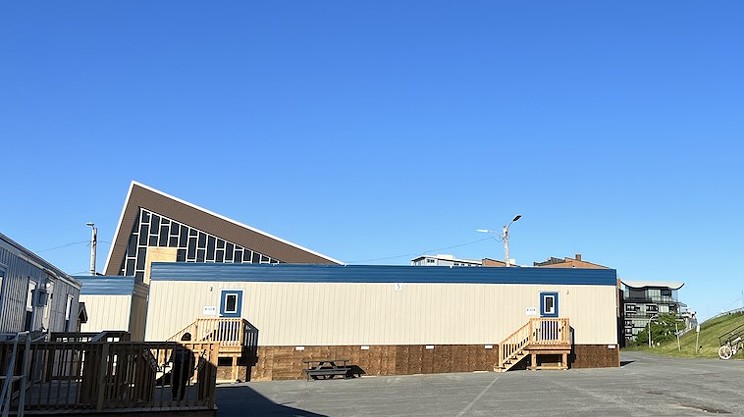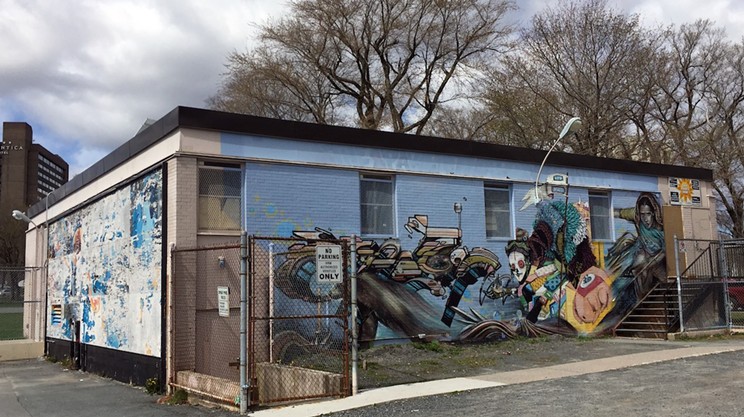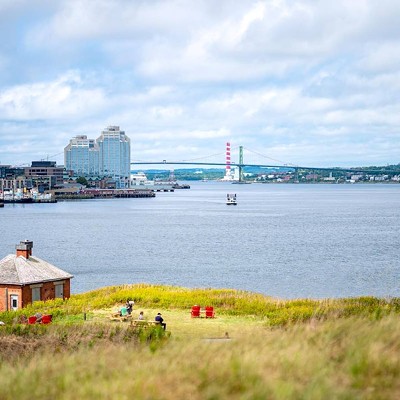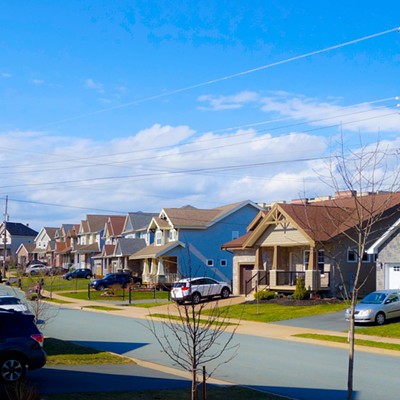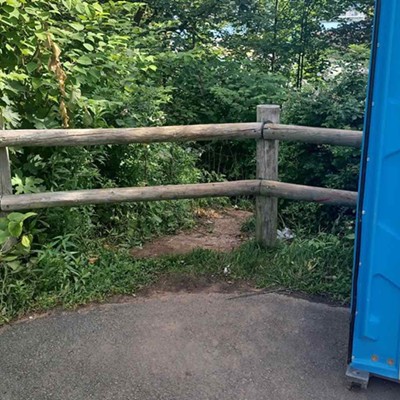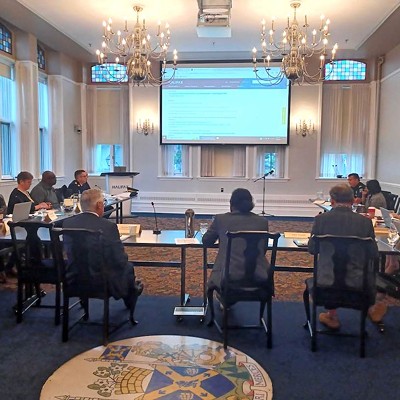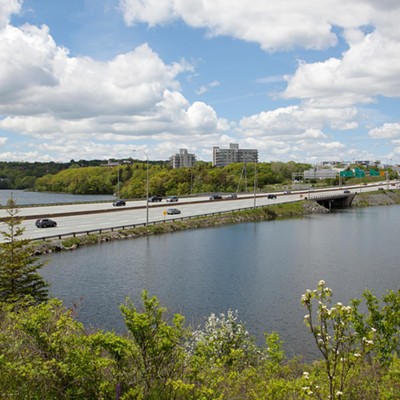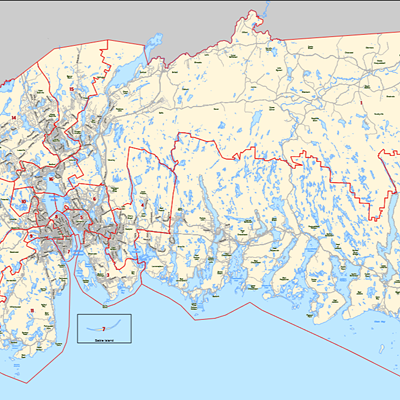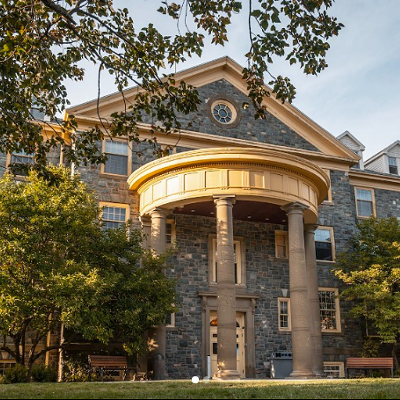Friday is a storm day in Halifax. The buses have stopped running. Schools are shuttered. Coffee shops have locked their doors and even Halifax Central Library is closed. In an early morning press release, HRM directs unhoused people to the Hfx Warming Centre.
The warming centre’s entrance to it isn’t particularly easy to find. The thick steel side doors are down a brick pathway next to St. Matthew’s United Church on Barrington Street, currently overshadowed by construction at the Maritime Centre next door. There’s no sign on the street, but a small laminated sign on the door reads “THE WARMING CENTRE IS OPEN TODAY” in large black type.
It’s comprised of two rooms in the basement of the original church building, built in the 1880s. Sunday mornings during mass, you can hear the choir upstairs through the wooden floor. On a recent visit before the storm, two people are hanging out in the main rec room, picking at the snacks left out while a movie plays on the flat-screen against one wall. Two staff members are in the nearby kitchen area, ready to open the locked door for anyone who knocks. A second room with even more chairs and couches appears empty at first glance, with the lights off and curtains drawn, but closer inspection reveals one person quietly napping beneath a blanket, safe, indoors and protected from the elements.
The warming centre is only available in winter, and even then not every day: Usually it opens from 9am to 9pm if the temperature drops below -15 degrees celsius, or if there are more than 25 centimetres of snow. The centre is run by people from a group of local charitable organizations including Out of the Cold Community Association, Adsum for Women & Children and MOSH, Mobile Outreach Street Health.
St. Matt’s reverend Betsy Hogan says the group came looking for a space in 2017, and the church happily agreed to provide it for free. “This is an actual way that we can feel useful,” Hogan says. “They make it possible, we can give them the space and sort of help them live in the space. We’re so grateful that we can offer our building to get used in this good way.”
Almost all the staff have another job at a shelter or doing outreach in the community. “It’s a lot of folks with harm reduction-based background or similar or related experience,” says warming centre coordinator Megan Malette, who also works at Out of the Cold.
Since COVID’s onset, St. Matt’s also began partnering with the warming centre to coincide with the church’s free breakfast program, paying to offset the cost of staffing the centre on Sunday mornings from 8am to 12pm. As a result, people can keep eating breakfast indoors.
That four-hour Sunday stretch is the only time the centre is reliably open. For the rest of the week, the centre’s schedule is less dependable. It has the funding to open about 30 days a year between approximately November and April. Mostly, it’s the coldest days, but sometimes—like on storm day Friday—it opens without quite hitting the benchmarks, the same ones used by the city to open the overnight shelter at the George Dixon Centre.
“We talk about what other kinds of weather we want to open for,” Malette says. “If the weather is a few degrees warmer than it’s mandated, are we still going to open and stuff?”
The Hfx Warming Centre is a stopgap measure. If everyone in the city had secure housing, it wouldn’t be needed. And that would be fine with the people running the centre. “We want people to be inside permanently,” says Malette. But that’s not the current reality.
The centre spends about $17,000 per year, to cover the costs of opening from from 9am to 9pm for 30 days every winter. That budget is funded by the province’s department of community services, which contributed $10,000 to the centre in 2021-22 (along with $20,000 to the George Dixon Centre for its overnight shelter), and $7,000 annually from the United Way.
At $17,000 for 30 days—a month—it would cost around $102,000 to open every day for six months. That much money would let the centre become a dependable service available all winter, no matter the weather forecast.
But the warming centre isn’t a solution, it’s only a band-aid for a grander issue. Most of the warming centre staff would rather see a bigger budget added to a shelter or supportive housing.
“When you think about what that investment means in just opening a drop-in space instead of putting that money towards people having housing. It’s kind of just like ‘god, that’s not the right move,’” Malette says. “The warming center is a drop-in space and was not created to be a shelter. And drop-in spaces are incredibly important. But housing is also really important.”
As a drop-in space, the warming centre doesn’t fix the housing crisis. It’s mostly a cozy basement where people can have a snack, charge a phone and relax. Malette says it’s not trying to be more than that. “It’s just a warm spot to maybe watch some movies for the day, have a coffee or some toast or Mr. Noodles, and just hang out and warm up for a little while,” she says.
As of February 1, the warming centre had been open 23 days so far this winter, according to its social media posts. Facebook and Twitter are important ways that Malette and other staff communicate that the centre is open.
“I also have what I feel like is a super extensive emailing list, that I send an email just notifying the community that it's opening,” Malette says. “So I have people from the hospitals, from the libraries, I have members of parliament, I have people from other organizations, Eric Jonsson is on that list, Rebecca”—Whitzman, the city’s new outreach worker—“is also on that list. Any resources that there are in the community, I've made sure to add a handful of people from.”
However, because many people without stable housing don’t have regular access to the internet, they often hear through word of mouth. “Some people don’t know because they don’t know precisely if it’s cold enough to be open,” says Eric Jonsson, the street outreach navigator for peninsula Halifax. “And a lot of times the way it is communicated is by email, so a lot of clients don’t know whether it’s open or not. So I guess if it was open more, maybe people would rely on it more.”
Laura, a volunteer at Halifax’s People’s Park, agrees the warming centre needs better communication. On a recent January day that was well below -15 with the wind chill, she says the centre wasn’t open. “I could not get any reason why, I asked people and they didn’t know. I’ve heard variously that it’s either staffing or funding,” Laura says. “If there is a funding need, somebody needs to ring the alarm bell.”
Laura doesn’t blame the organizers at the warming centre. “I think everybody is doing their best, I think my sense is that people are just overworked and they have a lot on their plate,” she says. However, she sees a real need among the unhoused population for more of what the warming centre and the George Dixon provide. “The best possible thing would be for both options to be open day and night until the end of the winter at the very least,” she says.
Malette says the warming centre organizing group has talked about opening the centre more often. “It's definitely a consideration, we've talked about it lots as the committee,” she says. But they are faced with a dilemma of combatting homelessness, between the immediate need for shelter and the long-term goal of housing. “It’s just the investment that it would cost to operate the centre, it just very much so feels like the money could be better spent elsewhere.”
Last year there was an average of about 10 visitors a day at the warming centre. Even if some of the people who are using the drop-in centre do have a shelter bed to go to at night, it’s good to have a change in scenery.
“It also provides an alternative for shelter users from staying indoors all day at the same shelter they may have slept in,” downtown councillor Waye Mason says on his website.
With $102,000, the warming centre could do that throughout winter, consistently. But where to find the money?
Councillor Mason declined to speak to The Coast for this article, but HRM media relations confirms the municipality does not contribute financially to the warming centre, and there is “no forecasted budget” annually for the George Dixon Centre overnight shelter, either.
However, compared to last week’s nearly $20 million worth of housing announcements, or the requested $2 million police budget increase, $102,000 is a drop in the bucket. A response from the department of community services said it is “not aware of the costing” of the warming centre. “The Department will always fund the overnight emergency shelter when the HRM Extreme Weather Committee activates the warming centre,” says a department rep.
An HRM spokesperson told The Coast “The municipality is continually working with the province to explore how it can best support activities related to housing and homelessness, including a concept of a more sustainable warming centre and emergency shelter model.”
In an ideal world, no one would need shelters or drop-in spaces. But in a world where homelessness exists and the housing crisis is only deepening, both are needed. And while the funding could perhaps stretch further at a shelter, it’s clear that warming centres fill gaps that no other group can.
If nothing changes in 2022, Halifax’s warming centre will continue to be open about 30 days of the six coldest months of the year. But as anyone who’s been outside in the Halifax weather knows, -14 feels just as cold as -15, and 23 cm of snow isn’t much less than 25.
“It’d be great if we could give these people housing,” Jonsson says. “But in the absence of a place to live, it’s a place where they can just sleep and get some food and warm up.”

